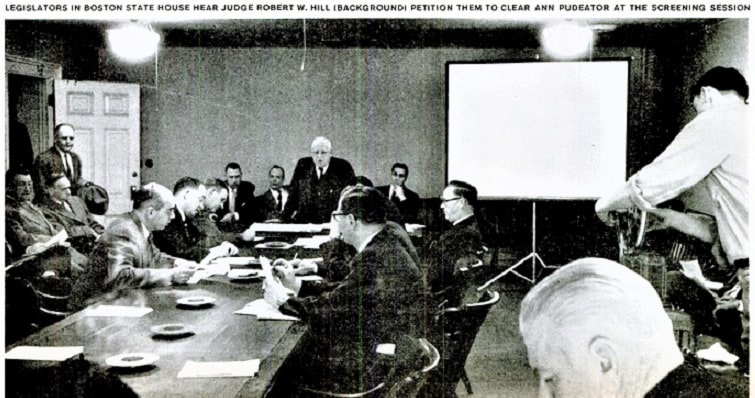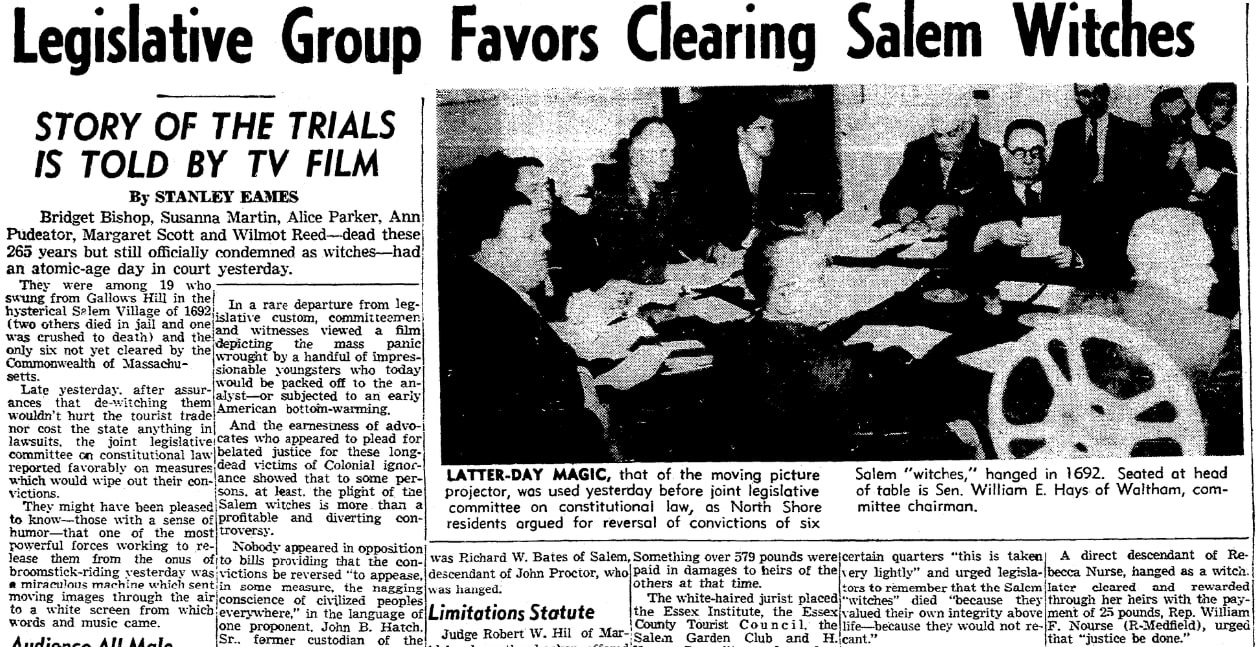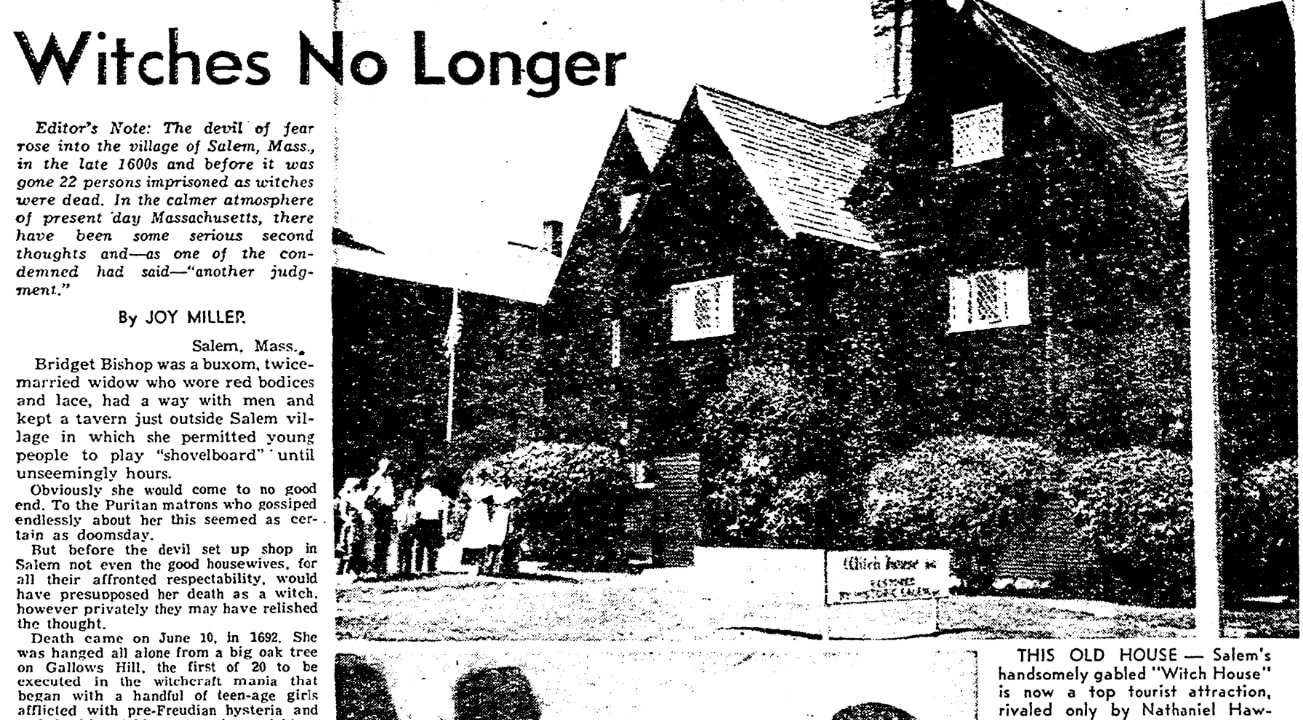Introduction: In this article, Melissa Davenport Berry writes more about efforts in the Massachusetts Legislature to clear the names of the victims found guilty of witchcraft in the Salem trials of 1692-93. Melissa is a genealogist who has a blog, AnceStory Archives, and a Facebook group, New England Family Genealogy and History.
Today I continue with the story about the efforts in the Massachusetts Legislature to clear the names of the victims found guilty of witchcraft in the Salem trials of 1692-93.

According to a Smithsonian Magazine article published in 2007, “A Brief History of the Salem Witch Trials: One Town’s Strange Journey from Paranoia to Pardon,” colonial authorities in 1711 pardoned most of the accused and compensated their families.
However, there were a few victims whose families were not there to request a pardon. I found several articles in GenealogyBank’s Historical Newspaper Archives that covered the continuous effort to absolve the victims left out and to pass a bill to clear all the victims charged.
There were two major concerns with overturning the convictions. First, some said it would be an empty gesture because the convictions occurred while the commonwealth was a colony of Great Britain. Second, some officials feared the financial burdens that might be placed on the state should the descendants seek damages.
Additionally, some argued it would hurt the tourist trade in Salem.
My last story ended with the hearings held by the state’s joint legislative committee on constitutional law in 1957, which included viewing a TV film from the CBS series Odyssey entitled “Satan in Salem.”
Life Magazine covered the hearings and published a story, “No Legal Switch to Clear a Witch.”

John B. Hatch, who spoke before the committeemen during the hearings, believed that justice could only be served via the English crown. Here is an article the Advocate newspaper published in August 1960, but I can tell you Hatch was continually in the press over this fight to exonerate the Salem witches.

This article reported:
Hatch’s eyes flash with zeal when he discusses his cause. “I am not a descendant, I have no affiliation with any sect or group, and I am not trying to embarrass the United States Government or the Queen of England,” he says. “I don’t stand to gain a thing. But someone has to try to get justice for these people. You can’t just let a crime rest because it happened a long time ago.”
The Boston Herald covered the legislative hearings in 1957.

I quoted from this article in my last story, but here are some more details:
Judge Robert W. Hill of Marblehead, another backer [of the legislation to exonerate the witches] offered two revisions: That the convictions be reversed “insofar as the Legislature has the power to do it”; and that no damage claims by descendants will be recognized.
“I should think,” said Sen. William E. Hays of Waltham, committee chairman, “that the statute of limitations should apply on that by now.”
Judge Hill pointed out that the six [accused witches] were not exonerated in a mass action of 1711 only because they had no relatives to ask that their names be cleared. Something over 579 pounds [English currency] were paid in damages to heirs of the others at that time.
The white-haired jurist placed the Essex Institute, the Essex County Tourist Council, the Salem Garden Club, and H. Vance Greenslit, a descendant of Ann Pudeator, on record for the bill.
“Some Salem people are a little ashamed,” Dr. Walter Merrill, director of the Essex Institute, told the committee. “But Massachusetts was the first state to make witchcraft a non-triable offense. We should add to that distinction by clearing all the witches. Let right be done by these dead.”
John R. Serafini, Salem city councilor speaking for the council, deplored the fact that in certain quarters “this is taken very lightly” and urged legislators to remember that the Salem “witches” died “because they valued their own integrity above life – because they would not recant.”
Col. Don J. Anderson of the Essex County Tourist Council declared, “The righting of a wrong never hurt anybody. It will be difficult to explain to Essex County tourists why you have not taken action to vindicate these people. I beseech you to clear them.”
A direct descendant of Rebecca Nurse [also spelled Nourse], hanged as a witch, later cleared and rewarded through her heirs with the payment of 25 pounds, Rep. William F. Nourse (R-Medfield) urged that “justice be done.”
Ralph C. Fitts of Myrtle Street, who described himself as the descendant of witch Susanna Martin, of certain jurors and of some witnesses in the trials, said: “I am very sure they (the victims) would want this bill passed.”
The bill, an evergreen, was killed in one form or another in 1946, 1950, 1953, and 1954.
It appears that by September of that year the matter was resolved, and the six remaining uncleared witches were given their just desserts – right on time for tourist season.
The headline story “Witches No Longer,” written by Joy Miller, appeared in several newspapers. Here is one from the Tulsa World.

This article reported:
For 265 years Bridget Bishop and five others remained branded as witches.
Late last month in a legislative resolve signed by Gov. [John Foster] Furcolo, she was, for all practical purposes, cleared of charges that included murdering a few neighbors, consorting with the devil, and causing a farmer’s cart to be stuck in a hole that later vanished.
Bridget owes her restored good name to Ann Pudeator, one of the last witches hanged and an upright woman who more than likely in her lifetime had very little good to say for the flashy tavern-keeper.
A dozen years ago H. Vance Greenslit, a descendant of Ann Pudeator – who had been Ann Greenslade before her marriage to Jacob Pudeator – looked up his genealogy. He was jolted to find a witch in the family.
Most of the witchcraft convictions had been reversed in 1711, but apparently no relatives were around then to speak up for Ann, Bridget, or Wilmot Redd, Susanna Martin, Alice Parker, and Margaret Scott.
Greenslit wrote to Robert W. Hill, a Salem lawyer now retiring as district judge after 37 years, to see what could be done about clearing their names.
“He got me interested,” Judge Hill recalls. “It seemed a simple matter. I said, ‘Sure, I’ll go ahead.’ I drew up a bill for a petition and State Sen. J. Elmer Callahan filed it with the clerk of the Massachusetts senate.
“It didn’t pass. One prominent legislator argued we were trying to rewrite history. So I’d put in the bill for a few years, lay off, put it in again. Some people said I was silly, but – and I never charged Greenslit a cent – I was just finishing a job. No one was going to be a whit different if it passed or not, but it would be correcting a wrong on the record.”
Much debate followed, in committee hearings such as mentioned above, going back and forth. Finally, A Resolve To Reverse The Attainders, Judgments And Convictions For Witchcraft Of Ann Pudeator And Others was passed in 1957.
For more information, visit the Salem Witch Trials Documentary Archive and Transcription Project.
Note on the header image: Witchcraft trial at Salem Village. The central figure in this 1876 illustration of the courtroom is usually identified as Mary Walcott. Credit: Wikimedia Commons.
Explore over 330 years of newspapers and historical records in GenealogyBank. Discover your family story! Start a 7-Day Free Trial.
Related Article:

Melissa, thank you for these series of articles. My wife is a direct descendant of Susannah North Martin, and we have always wondered why none of her children would speak up for her — during the trial or afterward. Maybe it was fear. Many lived in the area at the time — and I believe that there were at least eight that were living at the time of the trial. We have never visited the Salem area, and thanks to your articles we know we need to visit the sites you have highlighted. Interestingly, none of her ancestors on that side of the family had ever mentioned the family tie — and I’m not sure if was just forgotten over time or they chose to forget.
Loren, I am so happy you found this story. The Macy-Colby House in Amesbury has more information on Susannah Martin and her family.